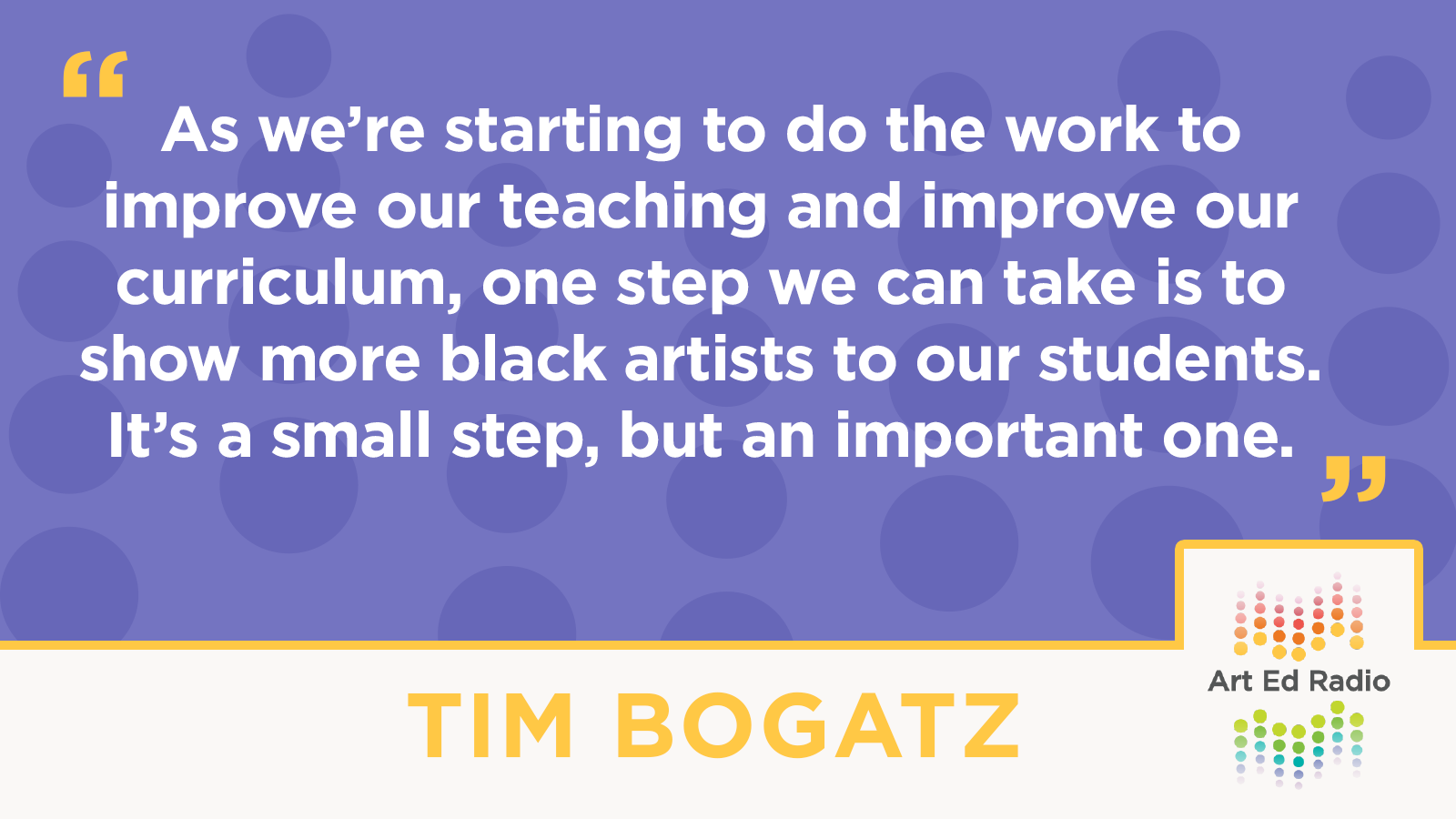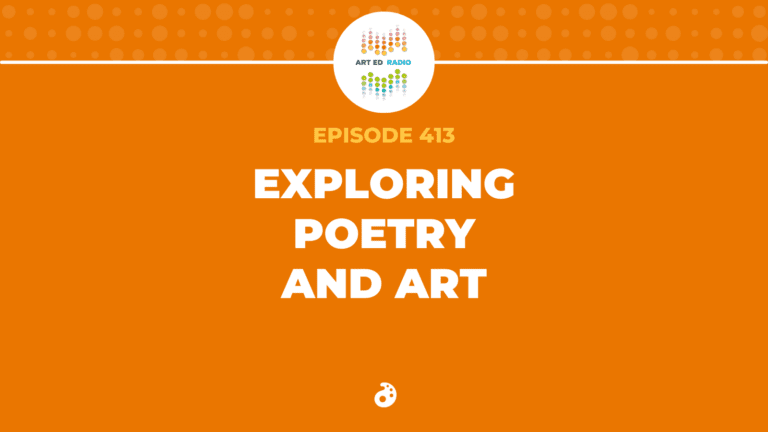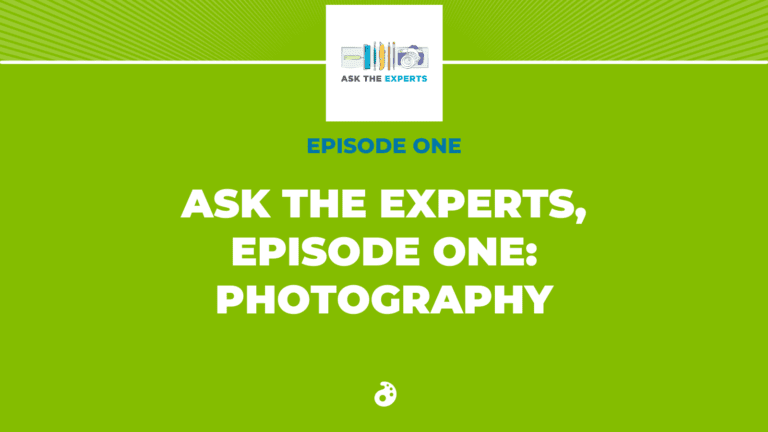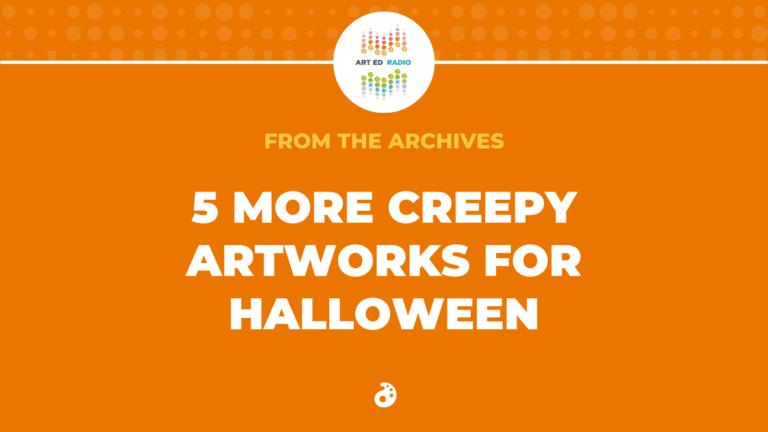With all that is happening in the world today, teachers everywhere are reflecting on their curriculum and doing the work to make their classrooms antiracist. A small step we can take is to show the work of more Black artists in our classrooms. In this episode, Tim discusses seventeen of his favorite living Black artists that you should know. Full Episode Transcript Below.
Resources and Links
- Download: 17 Black Artists to Know
- See Tim’s Twitter thread of living black artists
- The Perfect Project for Art and Activism
- How to Help Students Reflect, Process, and Enact Change
- Inclusivity for All Learners in the Art Room

Transcript
Tim: Welcome to Art Ed Radio, the podcast for art teachers. This show is produced by the Art of Education University and I’m your host, Tim Bogatz.
Now the topic that is on everyone’s mind right now, and the topic we need to discuss today, are the protests that are taking place all over the country, all over the world and the issues underlying those protests. And honestly, I guess I don’t necessarily even need to talk about the protests, I need to talk about the moment as a whole. I need to talk about what is happening in our world and our lives and our culture right now, and how all of those things affect our classroom. Because I think we are seeing a collective shift in the world of education.
Teachers want to know, “What can I do to make my teaching meet the moment we are in? Where do I start educating myself? How do I begin doing the work to make sure that my teaching and my curriculum are not only not racist, but make sure that they are antiracist?
It’s not easy work. It’s not quick work. Those are not easy questions or quick questions to answer. But I’m hoping here in today’s episode, I have an idea that may be a place to get started. It’s through the lens of art history. And I know looking at art history is not enough. It’s not enough. I know that there is more to be done and the job goes far beyond just the artists that we show to our students. But I think this is a valuable place to start, an entry point that helps us begin to do the work.
I want to do more, both long term and short term. But we’re going to begin today with me bringing up my love of art history, again, and talking about some of my favorite living black artists. And my hope is that you can use this list as a jumping-off point, a place to get started as you do your own research, as you educate yourself, as you begin to do the work.
And again, this is just list of my favorite living black artists. And it’s just a start. I’ll talk really briefly about each of them because I’m limited by time here, but we will have a download for you in the show notes that lists each artist and has a link to an article or an interview or a video where you can learn more about anyone on the list. You can continue to research, promote, amplify, and find amazing artists and share them out. Whether that is on social media, in your classroom, or however you find is the best way to share. So I hope that this list can help you along the way as you begin to do that. Now all of these artists that I’m going to list here come from a Twitter thread that I put together last week. So we’ll link to that in the show notes also. So if you want to see photos of the artists or images of the work they create, you can definitely check that out as well.
So our first artist is Mark Bradford. Now, he is just an incredible artist who creates these massive works with just layers upon layers upon layers of incredible work. There’s fabric, there’s paint, there’s just a huge variety of materials. And then he will sand down and dig down and carve down within there to find these incredible abstractions and they look just absolutely beautiful. So I think the thing that’s most fascinating about him and the thing that students respond to best is that everything he uses is everyday materials. And he has a quote that says, “If Home Depot doesn’t have it, Mark Bradford doesn’t need it.” And I think that’s just fantastic because to be able to create such massive, incredible works with just everyday materials is something that’s worth checking out. And my students have always responded really, really well to his work.
Number two is Mickalene Thomas. She creates these huge, I mean like 10-foot tall portraits, with acrylic and enamel. And she loves the rhinestones probably more than any other artists I’ve ever seen, that’s kind of her signature thing, is to add rhinestones to all of her works. And her portraits all sort of have a non … they all sort of keep an eye toward art history, which I think is really spectacular. Just these large striking portraits with a little bit of bling, a little bit of excitement in the portraits. And I think they’re fascinating to look at and really, really powerful pieces.
Number three is Julie Mehretu. She has, again, huge like room size, large scale paintings of abstracted landscapes. They’re very expressive, her mark-making is beautiful. It’s incredibly expressive. And just seeing all of these layers upon layers in her work with all of these expressive marks. It’s really kind of overwhelming if you see them in person, but it’s really fascinating to just see the size. And a lot of times when you look at her work, she’s on a cherry picker or some sort of machinery that helps her get up to the top of her work because they are so incredibly large. So like if a warehouse has a gallery, that’s the size that they need to be. They’re just absolutely huge and really fascinating to look at.
Number four is Betye Saar. She does assemblage, she does printmaking. But a huge amount of her work is just beautiful when it comes to storytelling. She is very active politically, has a lot to say in her work and directly confronts racism in a lot of the things that she does. And so I think there are a lot of learning opportunities when you look at her work. Just a lot of really good stuff there with context and starting conversations and being able to use her work as something that’s teachable. I think there’s a lot there.
Number five is Nick Cave. You probably know his sound suits, which are just these giant sculptural wearable pieces that are full of color and fabric and excitement and beauty. And the New York Times described him as the most joyful artist in America, and I can’t really say anything better than that. Just his work makes, I think everyone who sees it just incredibly happy. So if you can find some photos or some videos of his sound suits in action, they are just absolutely spectacular.
Number six, Rashid Johnson. I first found out about him, I think I saw online some drawings that he was doing and paintings that he was doing that has to do with anxiety and some of the emotions that kind of came with that. And then as I looked a little bit more at his work, it’s just so diverse. He does so many things. 2D work, he does 3D work, he creates installations, he does video, he does everything. And he does a lot dealing with racial and cultural identity, dealing with contemporary issues and social issues. Just a lot to dive into with his work. A lot to see there.
Number seven is Sam Gilliam. He pushes the envelope with paintings and fibers. I don’t know the right word for his work, the best I can come up with is tapestries. But basically he’ll just put canvas or fabric or whatever on the floor and create these beautiful paintings. They’re just so colorful, so expressive. It’s all abstract, but there’s just so much beauty in there. Just he’s a master of how he combines and uses colors. And then he will take that fabric or that canvas and then hang it up, which sort of turns it into this sculptural piece. And so it really blurs the line between, “Is this a 2D painting? Is this a 3D sculpture?” And it’s fascinating to look at and gives you a lot of opportunities for discussion about what art is and how we think of the different types of art that we create.
Number eight is Kara Walker. I think everybody’s familiar with Kara Walker, but she creates these beautiful black paper silhouettes, a lot of times taking up an entire room. And her subject matter explorers the issues of identity and race and gender and sexuality and even violence. Just an eye toward history, an eye toward the wrongs of the past and sort of memorializing those in very simple, but very, very powerful way. My kids always respond very well to her work. I think it’s something that you need to preview. You need to make sure your kids are ready for because those issues are heavy. But it goes back to that sort of idea on, how do we learn about this stuff? How do we discuss these things with our kids? And it’s up to us to do the work and figure out the best ways to converse with all of those things.
Number nine, Carrie Mae Weems, just one of the most incredible photographers working today. Honestly, one of the most incredible photographers in art history. Her portraits, her narrative, her storytelling that she comes through with her art is nothing short of amazing. I love everything, I think everything that she’s ever done. So if you’re into photography, you need to know and you need to shout out Carrie Mae Weems. She is amazing.
Number ten, Martin Puryear. He is a sculptor who keeps an eye on craft and traditional types of making, traditional materials. But he also challenges those materials to create these really evocative sculptures, these one-of-a-kind sculptures where things will be made of strips of wood, but yet he makes that word curve and bend in ways that wood is not supposed to curve and bend. And it creates these fascinating sculptures. And so whether you’re talking about craft or process or a finished product, there’s a lot to love there and a lot to look at in his work.
Number eleven is Maya Freelon. She creates these huge sculptural pieces using tissue paper and sometimes fabric. But just this beautiful texture and color that makes these very vibrant works. She’s young, she’s exciting, creates really, really cool things. And I think comparing and contrasting her work with Sam Gilliam makes for a really good discussion. Just kind of seeing how they use color, how they challenge materials, how they put things together is really, really worthwhile.
Number twelve, Glenn Ligon. If you are looking to talk about ideas and process and concepts, Glenn Ligon is perfect. He’s a conceptual artist. He deals with race and sexuality and he brings in so many different ideas from other subject areas, history and literature and language. And his use of text is absolutely incredible. And so just being able to explore some of his ideas are going to be really worthwhile in your classroom.
Hey, number thirteen is Kehinde Wiley. I don’t know how many times I’ve talked about Kehinde Wiley on my podcast. Maybe my favorite artist working today. Just these huge hyper-realistic beautiful portraits with beautiful backgrounds that celebrate black identity, that celebrate black culture while giving us a really significant critique of art history. And so there’s no limit to the number of things that you can discuss with Kehinde Wiley’s works. My kids have always responded so well to everything that he’s done. And it opens so many avenues to discuss art history and how black identity, how black culture can fit within art history. Just listening to interviews with him, watching videos about him, just hearing him talk about his work is really, really powerful. And of course he did Obama’s official presidential portrait, which is an incredibly famous work. So even if that’s your starting point with your students, it’s a great way to dive in and explore a little bit more.
Number fourteen is Kerry James Marshall. Just a beautiful portfolio of paintings that attempt to capture the black experience. Honestly, over the last 50 years or so 60 years from civil rights movement up to contemporary culture. Just this beautiful way of documenting what life looks like. And yeah, kids relate to those things very well. It’s very stylized, it’s very accessible and just really, really beautiful work. And I believe Kerry James Marshall also has murals up around the country, the one I’m thinking of I believe it’s in Chicago. And just being able to show kids some of his bigger work there is absolutely worth your time.
Number fifteen, Faith Ringgold. A while back Faith Ringgold was the keynote presenter at our Art Ed Now Conference. This was a while ago, I want to say like 2014, 2015. But she was an absolute riot, she was incredible to talk to. And she has such a long history as an artist and she’s done so many things. She is a painter, a writer, a sculptor, she does mixed media work. And I think what she’s most known for are her iconic quilts. I think everyone is familiar with tar beach. And if you’re not, you need to familiarize yourself with it. Just really powerful work, really powerful narratives and storytelling. And it’s absolutely something that you need to check out and something that you need to show your students.
Number sixteen is Amy Sherald. She has this very unique portrait style and just breaks with a lot of traditions and creates this very unique work. And I’m fascinated by it. I love looking at everything that she’s done. She was at the NAEA conference in Boston, I believe the national conference, and listening to her speak about her work was fascinating. She was a wonderful speaker, she had a lot of great stories and gave me a lot of insight into kind of her process and her work and made me appreciate it a little bit more. And she actually did Michelle Obama’s official portrait, the first lady. And so that’s a really, really good one. And again, a great entry point if you want to introduce her to your students.
And seventeen is Tatyana Fazlalizadeh. And she does these beautifully realistic portraits and street art. Just huge, huge works that are fascinatingly realistic. And she had an entire campaign called Stop Telling Women to Smile and it paired these wonderful portraits and realistic drawings with really important phrases that kind of make you think about behavior, about how we treat women, about how we objectify women. Just the one I’m thinking of has a portrait of, I believe three different women. The text below says, “Harassing women does not prove your masculinity.” And it’s an entire series like that which is really powerful. And again, leads you into so many issues that you can discuss, that you can talk about with your students.
And so those are my 17. It’s a lot, but honestly it’s just scratching the surface. I think if we can use that as a jumping-off point, you can continue to explore. You can continue to find the artists that speak to you, that will speak to your students and share them out however you can do that. Okay. Like I said, I appreciate you listening to some of my thoughts. I appreciate you listening to my ideas and my artists that I really love and really appreciate. And like I said, now it’s time to do the work. It’s time to explore. It’s time to find artists and share artists. And there’s a long way to go. But finding and sharing can be the first step because we’re going to work to meet the moment. We are going to work to educate ourselves and we’re going to work to make our teaching antiracist.
Art Ed Radio is produced by the Art of Education University with audio engineering from Michael Crocker. Thank you for listening, as always. I am hoping that we can continue the learning and continue to do the work next week. We’ll talk to you then.
Magazine articles and podcasts are opinions of professional education contributors and do not necessarily represent the position of the Art of Education University (AOEU) or its academic offerings. Contributors use terms in the way they are most often talked about in the scope of their educational experiences.



